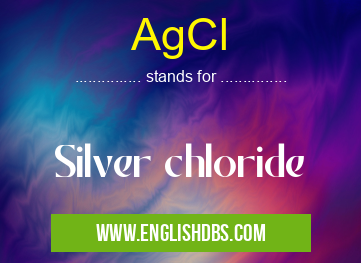What does AGCL mean in CHEMISTRY
AgCl is an abbreviation for the chemical compound silver chloride. It is a salt composed of positively charged silver ions, Ag+, and negatively charged chloride ions, Cl-. Silver chloride is primarily used as a light sensitive material in photography and x-ray imaging.

AgCl meaning in Chemistry in Academic & Science
AgCl mostly used in an acronym Chemistry in Category Academic & Science that means Silver chloride
Shorthand: AgCl,
Full Form: Silver chloride
For more information of "Silver chloride", see the section below.
Essential Questions and Answers on Silver chloride in "SCIENCE»CHEMISTRY"
What elements make up AgCl?
AgCl is composed of silver ions, Ag+, and chloride ions, Cl-.
How is AgCl used in photography?
AgCl is a light sensitive material used in photography and x-ray imaging. It can be used to develop images from negatives onto photographic paper or other light sensitive media.
Does AgCl have any other uses?
Yes, besides being used as a light sensitive material, AgCl has also been studied for its therapeutic properties to help treat infections caused by bacteria.
Is AgCl safe to use?
Yes, when handled properly and worn with protective gear, the use of silver chloride is generally safe. However, it should not be ingested or inhaled as it has the potential to irritate eyes and skin if mishandled.
Are there any side effects associated with using AgCl?
Yes, lengthy exposure to silver chloride can cause discoloration of the skin due to sensitization reactions. Proper safety measures should always be taken when handling this compound.
Final Words:
Silver chloride (AgCl) is an important chemical compound composed of positively charged silver ions and negatively charged chloride ions. Its primary use lies in photography and x-ray imaging as a light sensitive material but recent studies have proposed therapeutic properties for treating bacterial infections as well. Safety precautions should always be taken when dealing with this substance because misuse has the potential to cause skin irritations.
